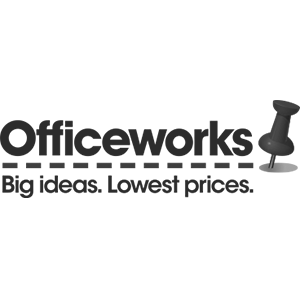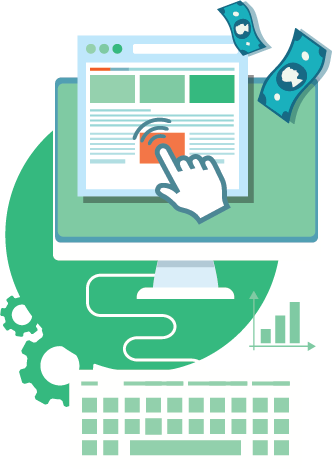
In this article, you’ll learn everything you need to know about Bounce Rate and how to apply this information to optimize your website. You’ll:
Bounce Rate is a term that describes the percentage, or rate, of visitors who immediately navigate away from your website, after viewing only one page.
Visitors are said to “bounce” because they come to your site and quickly leave. They don’t stay on your website, or interact with it.
Users bounce when they do things like:
The best way to understand bounce rate is through the image of a bouncing ball.

Imagine a bright orange basketball hitting the ground and immediately springing up. In this analogy, the ground is your website and the ball is the visitor. The quicker the ball pops off the ground, the harder the bounce.
A “hard bounce” is defined as a visitor who has arrived at and left your site within three seconds. The visitor has left your site so quickly, they’ve hardly had a chance to take it in.
Bounce rate is typically assessed through an analytics platform, like Google Analytics.
Google Analytics is a free web analytics platform, offered by Google. It tracks traffic and reports on the behavior and activity of your website visitors.
Because it offers free, comprehensive data, it’s the most widely used web analytics service on the Internet.
If you don’t yet have Google Analytics installed on your website, you can use it and start tracking data for free. (Simply click this link).
However, it's important to note, Google Analytics is undergoing so major changes. The current platform, known as, Google Universal Analytics (UA), is being phased out in July, 2023.
It will be replaced by an updated version known as Google Analytics 4 (GA4).
Bounce rate is defined differently in UA compared to GA4.
In UA, bounce rate is considered the percentage of sessions with a single page view. Time on site is not considered. So, if a user views a single page -- without clicking on anything -- then leaves, they're considered to bounce, no matter how long they spent on the page.
In GA4, bounce rate is defined and calculated differently. It is defined as the percentage of sessions in which users weren't engaged.
So if a users views a single page, doesn't engage with anything on the page, and leaves within 10 seconds, it's considered a bounce.
In contrast, an engaged session is considered to occur if a session lasts longer than 10 seconds, has at least 1 conversion event, or includes at least 2 page views.
Bounce rates are an important metric because they indicate users’ attention and engagement with your website. They show how satisfied your audience is in being able to find the information they’re looking for.
Bounce rate is slightly counter-intuitive metric in that, generally, the lower the bounce rate, the better.
A lower bounce rate shows visitors are staying on your page longer. They’re not arriving and immediately leaving. That’s usually a good thing.
Yes, it’s true. You want to facilitate users by offering them the information they’re looking for as quickly and easily as possible. But, if they’re immediately leaving your site as soon as they’ve landed on it, there’s likely an issue.
The more users who immediately leave, the higher the bounce rate on your site.
Bounce rate is calculated by dividing the total number of one-page visits by the total entries to your website.
For example, if your website sees 10,000 visitors in a month and 5,000 leave the homepage without going anywhere else on your site, the bounce rate on your homepage would be 50% (5,000/10,000).
Within Google's current Universal Analytics platform, bounce rate is displayed under the Audience/Overview section:

Along with a number of other metrics, it’s shown as a percentage, like this:

If you want to hone in on the bounce rate for a particular time period, or within a particular user segment, you can easily do so by adjusting your Google Analytics settings at the top of the Audience Overview screen:

Bounce rates are often confused with exit rates. But, they’re not the same.
Bounce rate measures the percentage of visitors who land on ONE page of your website and leave — without going deeper into your site.
Exit rate is the percentage of visitors who have left the page, compared to the total number of views on that page. Exit rates are recorded when the user leaves the site, regardless of whether they’ve been to one or more pages on your site.
Exit rate doesn’t take into account user activity prior to leaving the page. It only measures the rate of people leaving the page, against those who visited it.
So, for example, if the user arrives on your homepage and leaves almost as quickly as they’ve come, they’ve bounced.
But, if they’ve landed on your homepage, navigated to a product page, then immediately leave they’ve exited. The logic holds true, even if they were only on the product page for a millisecond because it’s the last page the viewed, before leaving.
Viewers always exit pages. They don’t always bounce.
In general, high bounce rates and high exit rates on a page are not great signs.
Monitoring your Google Analytics, looking for pages with both high bounce rates and high exit rates can be valuable, especially when assessed against pages with high page views.
As a great rule of thumb, if you can focus on optimizing a page with high pageviews and high bounce rates, you can work quickly to potentially optimize conversions.
In general, the higher the bounce rate, the more room there is to optimize.
You, ideally, want visitors to stay long enough on your webpage to find the information they’re looking for, take action, and convert. If they’re immediately leaving your site, they’re likely not gathering sufficient information to make a conversion decision.
As a general rule of thumb, an acceptable bounce rate is 70%, or lower. Any higher usually indicates a major problem.
An average-performing website has a bounce rate that hovers around 40-70%.
And, a bounce rate in the range of 26-40% is usually excellent, signifying you have highly engaged visitors.
However, these rates are very broad rules of thumb. Bounce rates vary highly by website purpose, industry sector, device type, and even by new or returning visitors.
Here is a benchmark comparison of bounce rates by website type:

And, here is a benchmark comparison of bounce rates by industry vertical:

As you can see, what’s considered an “average” bounce rate varies greatly.
To assess your bounce rate, you also need to look at your traffic. Are users primarily on desktop, tablet, or mobile? Bounce rates on desktop devices are usually lower than on tablet or mobile simply because it’s easier to browse most websites on larger screens – so less visitors immediately leave.
As well, it can be valuable to look at your bounce rate by new versus returning visitors. To do so, simply go to Audience/Behavior/New vs Returning in Google Analytics:

Then, look at your bounce rate by new and returning visitors:

It’s to be expected that new visitors will have a higher bounce rate than return visitors. Return visitors are coming back to your site because they’re interested in your products or content. But, if you bounce rate for return visitors is WAY higher, there’s likely an issue – and opportunity for optimization.
Overall, the best way to assess bounce rate is to benchmark your own site’s performance, overtime. If your bounce rate decreases as you optimize your site, that’s a great sign you’re doing something right!
As well, it’s important to keep in mind, a high bounce rate isn’t ALWAYS bad. Sometimes, it shows users have been able to quickly find what they’re looking for – like the answer to a specific question.
There are many reasons why visitors might bounce.
The simplest is, they didn’t intend to actually click onto your page. Ever click a link on your mobile phone that you didn’t actually want to open? Oops. When you immediately leave the page you just accidentally clicked, that’s precisely the type of action that Google Analytics considers a bounce.
Ever sit there waiting for a page to fully load and think to yourself, forget it. Then, just leave. That’s a bounce.
As discussed in this GuessTheTest article, slow-loading pages can be conversion killers. The longer it takes for a page to load, the less patient your users feel. And, as described in this GuessTheTest webinar, on how to optimize your site speed, many users will bounce, or leave your site, after just 10 seconds. Ideally, you want your page to load in 3-4 seconds, or less.
Ever go to a site and get hit with a pop-up add immediately upon landing on the page? Annoying, isn’t it? These are called interstitial pop-ups. And, they’re not only aggravating. They can also cause bounces. And, they’re penalized by Google. So, using them is not a great practice.
Beyond these reasons, the most likely reason a user is bouncing from your site is likely they’re not able to quickly and easily find what they’re looking for.
Here’s a real-life example I came across when helping optimize a client’s sock store.
The client had created a nice-looking Facebook ad showcasing several colorful patterned sock styles. The ad looked like this:

But, when visitors clicked on the ad, they were brought to the sock store homepage – and couldn’t easily find the specific socks showcased in the ad. The homepage looked like this:

None of the socks shown in the ad were reflected in the hero image. The product imagery featured in the ad was not congruent with what appeared after the user clicked on the ad and landed on the site.
Upon clicking the ad – and landing the site – shoppers wanting a specific sock design shown in the ad had one of two choices:
Can you guess what most users did?
They bounced!
In fact the client’s analytics data showed Facebook ad traffic was the largest, but heaviest bouncing traffic source.
In the sock example, there was no “message to market match.” In other words, there was no continuity between the ad and the onsite experience.
Visitor couldn’t easily find the product they wanted on the website, even though it has just been displayed in the ad.
Shoppers, undoubtedly, went from happy and excited about the product to confused, upset, or overwhelmed by the daunting task of having to search through dozens of sock styles just to find the ones that had captured their interest in the first place:

So, they bounced.
The remedy: create a message to market match.
If you showcase ads with specific products, like a certain style of socks, consider creating a landing page linking directly to that specific product.
Or, if you’re bringing visitors to a homepage with multiple products, ensure you feature that specific style (or styles) – clearly and visibly – on your site. So, users don’t have to go searching for them.
Web accessibility, for blind, disabled, or elderly users, isn’t always given a lot thought.
But, if you consider creating a highly accessible site, you’ll be doing yourself a big favor for two reasons:
Web accessibility and a cleanly designed site go hand-in-hand.
When aiming to design a great site, there are many factors to consider. Some of the most basic and best-converting changes you can make include:
And, if you’re gung-ho on web accessibility, and want to take it to the next level, check out this website for inspiration. In the top header, they’ve created a dropdown, fully customizable, interactive web style sheet you can modify and change to suit your web viewing needs:

As discussed, visitors don’t give a lot of grace to slow-loading sites.
As described in this GuessTheTest article, some research shows we make an impression about a website in just 0.04 milliseconds. And, if a page takes more than a few seconds to load, we’re probably just gonna leave. In fact, this graphic shows just how lethal a slow-loading site can be at increasing the rate of visitors who bounce off your site:

Take active measures to reduce slow-loading sites. Google Analytics provides specific suggestions your can follow. To access these suggestions, go to Behavior/Site Speed/Speed Suggestions:

Then, follow the specific suggestions outlined, by page.
As well, you can use tools like GTMetrix and Pingdom to help assess and analyze how to optimize your site speed. For detailed, specific implementation instructions, check out this GuessTheTest video tutorial.
A bouncing visitor may be done with your site, but there’s still one last chance to snag them before they walk out the door – and probably never come back. That last chance is through the form of an “exit intent” pop-up that triggers as the user motions to leave the site.
The pop-up may show an offer, or attempt to capture the visitor’s information for later follow-up. Here’s an example of an exit intent pop-up that I tested and was implemented on a client’s personal injury law firm site:

After assessing the client’s analytics data, I saw their bounce rate was very high. Many visitors were leaving without requesting a free quote. So, I suggested we create an exit intent pop-up to capture contact information. We tested a version with the pop-up and another version without the pop-up.
Simply adding this pop-up, which triggered as the viewer went to exit the site, has resulted in an enormous increase in contact submissions. And, a happy client. Something so simple as an exit pop-up really can make a difference. And, while it won’t directly reduce your bounce rate, it may mean the difference between a bouncing visitor and one whose contact info you now have for follow-up.
There’s lots of great exit intent platforms out there. A couple of the ones I recommend trying include Optin Monster, or WisePops. Many products, like Unbounce and Clickfunnels also enable you to set-up and test custom exit pop-ups directly within the platform.
So, it’s easy to test it out and see for yourself.
Hope you’ve found these suggestions useful and informative. Please share your thoughts and comments in the section below.
A primer explaining the 4 different types of tests you can run, what they mean, and how you can use each to improve your competitive testing advantage.
One of the most debated testing topics is how large does my sample size need to be to get trustworthy test results? Some argue samples of more than 120,000 visitors per variant are needed to begin to see trustworthy test results. Ishan Goel of VWO disagrees. What does he think is needed to get trustworthy test results? Listen to this webinar recording to find out.
To get users clicking your content, which format works best: buttons or links. A series of 8 real-life A/B tests suggests one format consistently outperforms. Can you guess which version wins? Checkout the mini meta analysis to find out.














Hi Deborah,
Nice Article on Bounce Rate. I believe this is one of those topics which SEO Service providers discuss alot because they are able to provide good traffic but not good leads which lead them directly to bounce rate. Higher it is lesser the chances of sales.
I loved your Industry-wise Bounce rate chart, helps a lot in understanding the current situation of SEO as per different industries.
[…] care about your site. Generating traffic is often the most difficult and time consuming aspect of setting up a successful website and so bypassing this step by using existing websites is a great way to save time and maximise […]
[…] This can be a huge deterrent to anyone who is visiting your website. The website will not load until after the visitor agrees to proceed to the website. The bounce rate for websites without an SSL certificate is 70%. Source […]